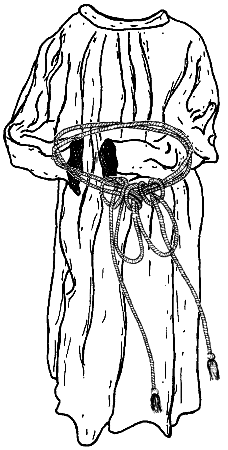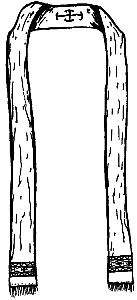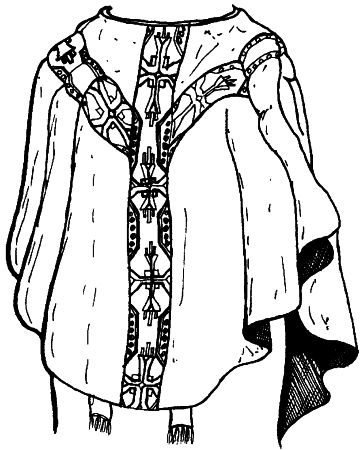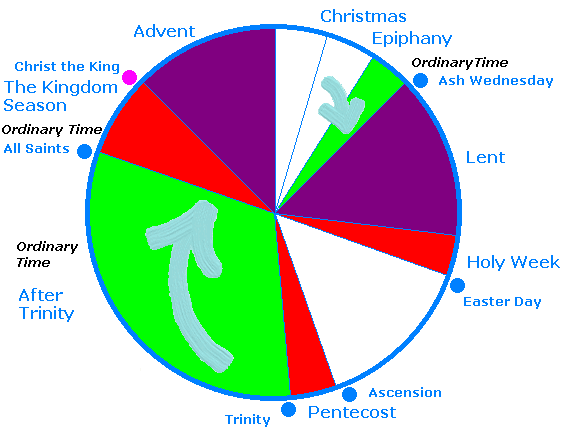|
|
|
The early Church did not wear special vestments except for a white garment worn at baptism that was like 'putting on' Christ. Otherwise people worshipped in their own homes including for the agape meal and Eucharist. Everyday dress was often a white tunic down to the feet, with a knee-length coloured garment with a hole in the centre worn dropped on top. These linea and casula became the special dress of alb and chasuble today. Deacons, who had the care of widows and the sick, adopted the dalmatic tunic of Roman officials, and so it remains worn with the simpler tunicle for sub-deacons.
|
|
After 313 CE and the Edict of Milan Christianity became the official religion of Rome and then churches were built in the form of basilicas with greater ceremonial possible. The girdle and pallium (a scarf, to become the stole) were introduced after some time.
|
|
|
|
After the Roman Empire there was a steady decline in the use of vestments, and any special dress retreated to the clergy.
|
|
In the Protestant Reformation, from the 1500s on, the alb and chasuble were replaced by the surplice. This matched the infrequency of eucharists amongst Reformers. The Church of England went through its Puritan disintegration with a radical simplicity of dress and actions and was not greatly restored to any elaboration of worship afterwards. Rationalism and the religion of the State mitigated against special dress.
|
|
Much Catholic appearance was restored and developed after 14 July 1833 (John Keble's Assize Sermon) with the Oxford or Tractarian Movement (the publication of many Tracts for the Times promoting what became known as Anglo-Catholic traditionalism. In most Anglican churches, if after a struggle, candles, a surpliced choir, wafers instead of bread, crucifixes, statues, stone altars and stations of the cross appeared. So did mediaevalist Mass vestments, starting with a coloured stole included alb, cicture, collar and chasuble. Then different colours (see below) reflected Christian seasons. So did ceremonial movements (see further below). Even later there were Latin Masses, reserved elements of the consecrated Eucharist and devotions to them, processions, incense, invocation of the saints, and the bishop in greater elaborate ceremonies acquired a hat called a mitre. The derived Gothic Revival affected every denomination to some degree. The Broad Church movement developed a via media of practices as a middle ground of the Anglican Church as a whole, its liberality contrasting with the outer excesses of reinvented traditionalism but also reflecting aspects of tradition.
|
|
Today postmodernism promotes the role of the symbolic, the colourful and the different. A function of worship is to stand out and to be distinctive. Into this goes a whole set of rules inherited or revived from the past for authority, legitimacy and a sense of the numinous, and some that look like the past but are more recent (for the same reasons). Postmodernism creates a number of challenges regarding worship. One is its rejection of a metanarrative, when Christian worship is a metanarrative - or at least it is a narrative of the community recognising that other religious communities have their narratives (and remembering that different Christians have their own variations on the narrative through their own traditions). Whilst worship can be striking, a temptation with postmodernism is to regard everything as simulacra and entertainment. It might be simulacra, but it should not be entertainment - whilst aspects can be joyful, worship (however regarded) should lead towards different contemplative states and a reduction in desire. Worship can also reflect different lifestyles: a difficulty with Anglican worship is that even now its texts reflect an agricultural monarchical and feudal society (even in 1662 the Book of Common Prayer had archaism built in) and, inevitably, these have an uncritical reflection of small town and village Middle Eastern society with its supernaturalism from the time of Jesus.
|
|
When a bishop calls at a local church he (or she in many provinces) may make some changes. A mitre is worn, a divided hat that represents the tongues of fire said to have come on to each disciple's head at Pentecost. A crozier is carried, shaped in the form of a shepherd's crook for the main shepherd in the area. |
|
Coloured vestments add to the sense of the part of the Church year arrived at and add to the sense of passing through the year.
|
|
|



